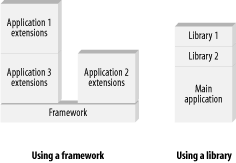I have been using the term framework in this chapter without having defined what exactly it is, or how it adds value in software development. In its simplest form, a framework is a set of classes and interfaces that cooperate to solve a specific type of software problem. A framework has the following characteristics:
A framework comprises multiple classes or components, each of which may provide an abstraction of some particular concept.
The framework defines how these abstractions work together to solve a problem.
Framework components are reusable.
A framework organizes patterns at a higher level.
A good framework should provide generic behavior that many different types of applications can make use of.
There are many interpretations of what constitutes a framework. Some might consider the classes and interfaces provided by the Java language a framework, but these are really a library. There’s a subtle, but very important, difference between a software library and a framework. A software library contains functions or routines that your application can invoke. A framework, on the other hand, provides generic, cooperative components that your application extends to provide a particular set of functions. The places where the framework can be extended are known as extension points. A framework commonly is referred to as an “upside-down” library because of the alternate manner in which it operates. Figure 1-5 illustrates the subtle differences between frameworks and software libraries.
Get Programming Jakarta Struts now with the O’Reilly learning platform.
O’Reilly members experience books, live events, courses curated by job role, and more from O’Reilly and nearly 200 top publishers.


